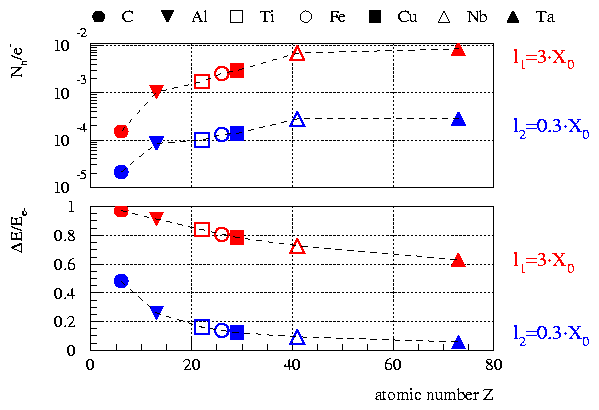
Calculation of Neutron Production using FLUKA
B. Naumann and E. Grosse
For the estimation of activation and background neutron radiation in physics
experiments at ELBE the knowledge of the photoneutron production in structural
components of the electron accelerator is required. Detailed calculations of
such processes are especially important as
at ELBE it is planned to use the neutrons generated from the electron beam [1].
For time of flight studies sub-nanosecond neutron pulses may be obtained [2].
In traditional nuclear physics transport codes as
EGS4 [3], GEANT [4] or MCNP [5] photonuclear reactions are not implemented
and the neutron production can only be approximated in a two-stage technique
by converting a bremsstrahlung photon fluence
into a neutron source, as described in [6].
Thus the Monte Carlo radiation transport program
FLUKA [7] was implemented for simulating
not only electromagnetic interactions of photons and electrons,
but also photonuclear reactions and the subsequent neutron propagation. The present status of the FLUKA
photonuclear cross-section database is documented in detail in [8].
The photonuclear cross-sections from the FLUKA database
were compared with experimental data from [9] for various materials with
nuclei of 6 £ Z £ 73 and a good agreement was found for nuclei with
Z ³ 13.
Using the program FLUKA tracking calculations of the
full particle cascade in irradiated materials
have been done for the neutron production in various
beam dump materials [10]. Here
the emitted neutron
yield per incident electron and the energy deposition in various materials
with widely different Z are presented for 50 MeV electrons (see Fig.1).
For these calculations the size of the
target was scaled with the radiation length X0, the radius of the cylindrical target
being X0 and its depth 0.3·X0 or 3·X0, respectively.
The smooth Z dependence of both plotted quantities, when scaled with their
radiation length, allows a straightforward interpolation to other materials.

References
[1] H. Freiesleben et al., Neutrons at ELBE, Annual report 1997,
FZR-215 (1998)14.
[2] B. Naumann and E. Grosse, this Report p. 35
[3] W. R. Nelson et al., The EGS4 Code System, SLAC-Report-265 (1985).
[4] GEANT, CERN Program Library W5013 (1994).
[5] J. F. Briesmeister, Editor, MCNP, Version 4A, LA 12625 M (1993).
[6] B. Naumann and W. Neubert, this Report p. 37
[7] A. Fasso et al., Proc. of the 8th Int. Conf. on Rad. Shielding,
Arlington (1994)643-649.
[8] A. Fasso et al., Proc. of the III Spec. Meeting on Shielding Aspects,
Sendai (1997)61-74.
[9] EXFOR-Database of the IAEA, http://iaeand.iaea.or.at/exfor.
[10] B. Naumann et al., Strahlfänger für maximale Energien an ELBE,
FZR Report FZR-267 (1999).
| |
|